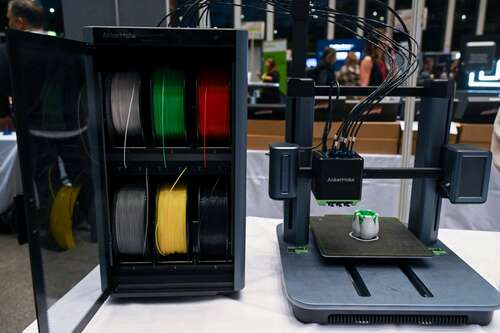
The first ever printer I saw in real life was a noisy Epson dot-matrix home printer that could render black and white images in terrible detail. That’s what 3D printing has been like so far, but it is possible these days to be less monochromatic.
Paint It
The simplest way to give color to a 3D print is to paint it by hand. Print in a good base color, such as white filament, and then use acrylic paints to finish your model. This is the cheapest method to get fantastic full-color models, but you’re not going to make lots of models this way and, of course, it’s labor-intensive. Not to mention, if you have no talent for painting, the results might be less than appealing!
Pause and Swap Filament
If you want to print a single model in multiple colors, the most straightforward way to do it is by swapping filaments mid-print. This will obviously change colors and material along the Z-axis, as you’ll be laying the new filament on top of the old filament.
There are various different printers, printer operating systems, and slicing software, so the exact way to do this will depend on your setup and what software and hardware you use. Luckily, it should be as easy as searching for your printer’s name along with the term “filament swap” for exact details on how to do this mid-print.
Most slicing software will also let you modify the G-code (the instructions sent to the printer) to insert a filament swap command. Once the printer reaches the correct layer, it will stop and wait for you to put in new filament before printing the rest. Of course, your printer needs to support this function as well.
If your setup doesn’t allow for this precise, sanctioned, and elegant filament swap method, instead you can use the tried and tested eyeballing method. Just hit pause on your printer when it looks like it’s at about the right spot, and swap out the filament before resuming. Some experienced 3D printing gurus don’t even bother pausing the print. They just cut off the current filament and then manually feed new filament into the printer without missing a beat.
Print in Two Separate Sessions
For models that aren’t printed in one piece (or that you can slice up into different pieces), the easy answer is to print the pieces in different sessions with different filaments or on different printers. For example, if you were printing a model tank, you could print the body in a military green filament, and print the treads in black. You can also add basic interest to models that have to be assembled by printing one set of parts in one color and another in a second color, and then swapping out parts between the sets.
Use a Multi-Color Filament
If you don’t care about specific parts of your model being a particular color, you can also experiment with multicolor filaments. For example, rainbow filaments change color every few feet, which means if you print multiple copies of the same model you’ll get unique color variations in each one.
There are also filaments that have two strands of color running in parallel, which also offers interesting multicolor blends. It’s not exactly true color printing, but it beats having just a single color for your whole model.
Buy a Multicolor 3D Printer
3D printers have come a long way since the early days of the RepRap, and there are now multicolor, multi-material 3D printers that can produce intricate objects that rival traditionally-made products. As you can imagine, being able to print in multiple colors comes at a price.
For example, the Bambu X1 Carbon Combo 3D Printer is around $1500 as of this writing, which is a healthy chunk of change. However, that’s not miles away from flagship mono 3D printers like the Creality K1 Max. So if you really, really wanted the ability to precisely print things in multiple colors and materials, it’s not that far out of reach.
Use a Multi-Color Print Service
3D printers are expensive, and getting the most out of them requires considerable expertise. So it’s no surprise that 3D printing services have popped up all over. Just like a paper printing service, you send your 3D models to these services, and they’ll send you your prints.
Some of the larger outfits have access to truly advanced “indirect” color 3D printers, where the printer will essentially paint the model using precise nozzle sprays with CMYK colors just like a professional printer. Although most will likely only have “direct” color printers that use colored filaments, and so will only offer a few colors at once.
Online 3D printing services like Sculpteo and Xometry tend to sell their services to other businesses, and not for small print jobs like your local 3D print shop, but I think with the drop in costs for multicolor printers there’s a good chance your local will offer some of these options soon, if they don’t already.

